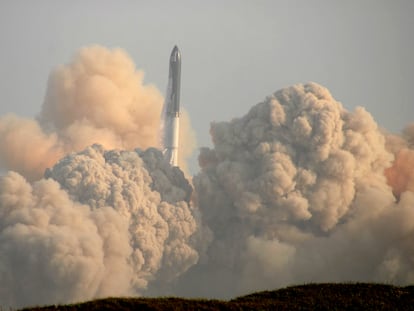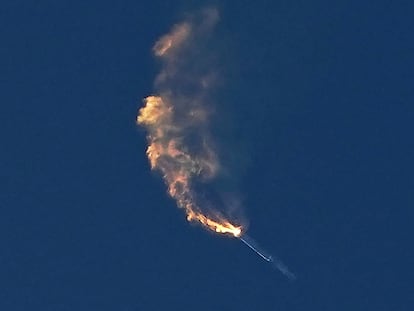Elon Musk’s SpaceX will attempt second full test flight of ‘Starship’ again Friday
The U.S. Aviation Authority has reactivated authorization for another attempt after the explosion during the first launch last April


The countdown has started again. After last April’s failed test flight, Elon Musk’s company SpaceX has announced that this Friday November 17 at 7 a.m. Central Time (8 a.m. ET), a new window opens for the second full flight test of its gigantic 120-meter-high Starship spacecraft, coupled to the Super Heavy booster, the most powerful rocket in history.
The company’s announcement came moments after the U.S. Aviation Authority (FAA) said it was reactivating SpaceX’s authorization. “The FAA has given license authorization for the second launch of the SpaceX Starship Super Heavy vehicle,” the agency stated. “The FAA determined SpaceX met all safety, environmental, policy and financial responsibility requirements.”
In a 45-page report, the FAA reviews some of the incidents that occurred during the first test launch earlier this year and the improvements SpaceX has since made to prevent a recurrence. On April 20, the spacecraft overshot the pad and the beach and eventually disintegrated when it exploded over the Gulf of Mexico. The concrete launch pad was damaged during the test launch, resulting in the scattering of sand and debris, some of which was deposited outside the potential debris study area assessed in the authorization. The rupture of the launch pad deck also ejected sand underneath the launch pad from the thrust of the spacecraft.
All in all, SpaceX deemed the launch a success because the rocket moved a sufficient distance away from the launch pad without causing damage and the failure occurred at a later stage, during the undocking of Starship and the Super Heavy booster. " Starship’s first flight test provided numerous lessons learned that are directly contributing to several upgrades being made to both the vehicle and ground infrastructure to improve the probability of success on future Starship flights,” SpaceX said in an update in September. Even so, the wreckage at the launch area after the first test flight concerned the authorities, which put SpaceX’s now reactivated license on hold.
Following the April 20 launch, the FAA explains, SpaceX reinforced the launch pad foundation with thicker concrete and additional reinforced piles and installed steel plates over the foundation. Both improvements are designed to protect the pad from a potential breakup and a debris field. The steel plates include a water-cooling element to protect them during an engine ignition event while also allowing the plates to be reused.
SpaceX has also added a forward heat shield to the Starship/Super Heavy vehicle to provide thermal protection against heat produced by the craft’s engines during a stage separation event. The second test will also debut a new electronic thrust vector control system.
“This rapid iterative development approach has been the basis for all of SpaceX’s major innovative advancements, including Falcon, Dragon, and Starlink,” said SpaceX, which considers such a system “essential” in its work " to build a fully reusable launch system capable of carrying satellites, payloads, crew, and cargo to a variety of orbits and Earth, lunar, or Martian landing sites,” according to the statement announcing the upgrades.
Friday’s launch window lasts two hours. About 30 minutes before liftoff, SpaceX will begin a live webcast of the flight test, both on its website and on the X social network, which is also owned by Musk.
Sign up for our weekly newsletter to get more English-language news coverage from EL PAÍS USA Edition
Tu suscripción se está usando en otro dispositivo
¿Quieres añadir otro usuario a tu suscripción?
Si continúas leyendo en este dispositivo, no se podrá leer en el otro.
FlechaTu suscripción se está usando en otro dispositivo y solo puedes acceder a EL PAÍS desde un dispositivo a la vez.
Si quieres compartir tu cuenta, cambia tu suscripción a la modalidad Premium, así podrás añadir otro usuario. Cada uno accederá con su propia cuenta de email, lo que os permitirá personalizar vuestra experiencia en EL PAÍS.
¿Tienes una suscripción de empresa? Accede aquí para contratar más cuentas.
En el caso de no saber quién está usando tu cuenta, te recomendamos cambiar tu contraseña aquí.
Si decides continuar compartiendo tu cuenta, este mensaje se mostrará en tu dispositivo y en el de la otra persona que está usando tu cuenta de forma indefinida, afectando a tu experiencia de lectura. Puedes consultar aquí los términos y condiciones de la suscripción digital.
More information
Archived In
Últimas noticias
ChatGPT fails the test: This is how it endangers the lives of minors
The late consecration of women artists in their 90s
The Florida Keys tourist paradise is besieged by immigration agents: ‘We’ve never seen anything like this’
The latest scam on WhatsApp behind the legal dream: using immigration status as bait
Most viewed
- Families demand repatriation of bodies of Colombians who died in Ukraine: ‘This war is a slaughterhouse for foreigners’
- The low-cost creative revolution: How technology is making art accessible to everyone
- Liset Menéndez de la Prida, neuroscientist: ‘It’s not normal to constantly seek pleasure; it’s important to be bored, to be calm’
- Christian Louboutin: ‘Young people don’t want to be like their parents. And if their parents wear sneakers, they’re going to look for something else’
- ‘El Limones’ and the growing union disguise of Mexican organized crime










































